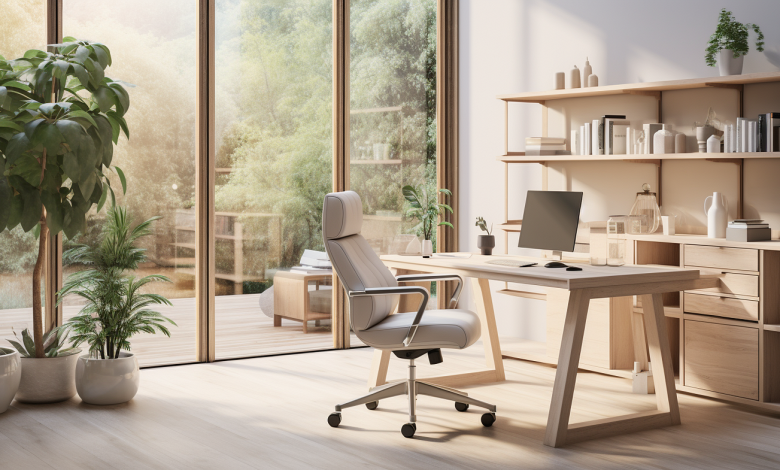Creating the Perfect Home Office: Ergonomic Chairs and Standing Desks

In today’s world, where remote work is increasingly becoming the norm, setting up a home office that promotes comfort, productivity, and well-being is essential. Two critical components of such a setup are ergonomic chairs and standing desks. These pieces of furniture not only enhance your comfort but also contribute significantly to your overall health. Here’s a comprehensive guide on why you need an ergonomic chair and a standing desk for your home office and how to choose the best ones.
The Importance of Ergonomic Chairs
1. Support and Comfort: Ergonomic chairs are designed to provide maximum support and comfort, which is crucial for those who spend long hours seated. Unlike regular chairs, ergonomic chairs support the natural curve of your spine, reducing the risk of back pain and discomfort. They come with adjustable features such as seat height, backrest tilt, armrests, and lumbar support, allowing you to customize the chair to fit your body perfectly.
2. Enhanced Productivity: Comfortable seating can significantly enhance productivity. When you’re not constantly shifting in your seat or experiencing discomfort, you can focus better on your tasks. An ergonomic chair helps maintain proper posture, which can reduce fatigue and improve your efficiency.
3. Long-Term Health Benefits: Using an ergonomic chair can help prevent chronic issues such as musculoskeletal disorders. By promoting proper posture and providing adequate support, these chairs reduce the strain on your back, neck, and shoulders, helping you maintain good health in the long run.
Choosing the Right Ergonomic Chair
When selecting an ergonomic chair, consider the following factors:
- Adjustability: Look for a chair with adjustable seat height, backrest, armrests, and lumbar support.
- Material: Choose a chair with breathable fabric and sufficient padding for comfort.
- Swivel and Casters: A chair that swivels and has casters allows for easy movement and access to different parts of your workspace.
- Lumbar Support: Ensure the chair provides firm support to the lower back.
The Benefits of Standing Desks
1. Improved Posture: Standing desks encourage you to stand more often, which can help improve your posture. Alternating between sitting and standing can reduce the strain on your spine and prevent the slouching that often occurs when seated for long periods.
2. Increased Energy and Focus: Standing while working can boost your energy levels and help you stay more alert. It promotes better circulation and can reduce feelings of fatigue, making you more focused and productive.
3. Reduced Risk of Health Issues: Prolonged sitting has been linked to various health issues, including obesity, cardiovascular disease, and diabetes. Standing desks help mitigate these risks by allowing you to break up long periods of sitting with standing, promoting a more active lifestyle.
Choosing the Right Standing Desk
When selecting a standing desk, consider the following factors:
- Height Adjustability: Choose a desk with adjustable height settings to easily switch between sitting and standing positions.
- Surface Area: Ensure the desk has enough space for your computer, accessories, and other work materials.
- Stability: Look for a desk that is stable and sturdy, even when fully extended.
- Ease of Adjustment: Opt for a desk that is easy to adjust, whether it’s manual or electric.
Combining Ergonomic Chairs and Standing Desks
To create the ideal home office setup, it’s beneficial to combine an ergonomic chair with a standing desk. This combination allows you to switch between sitting and standing throughout the day, promoting better posture and reducing the risks associated with prolonged sitting.
Tips for an Effective Setup:
- Ergonomic Chair: Use the chair when you need to sit, ensuring it is adjusted to support your posture.
- Standing Desk: Alternate between sitting and standing, aiming for a balance that suits your comfort and productivity levels.
- Monitor Height: Ensure your computer monitor is at eye level to avoid straining your neck, whether sitting or standing.
- Anti-Fatigue Mat: Consider using an anti-fatigue mat when standing to reduce the strain on your legs and feet.
Final Thoughts
Investing in an ergonomic chair and a standing desk is a smart move for anyone looking to improve their home office setup. These pieces of furniture not only enhance comfort and productivity but also contribute significantly to your long-term health and well-being. By carefully selecting and combining these elements, you can create a home office that supports your work habits and promotes a healthier lifestyle.
Whether you’re working from home temporarily or have made it a permanent arrangement, prioritizing ergonomics in your workspace will pay off in terms of improved comfort, reduced health risks, and enhanced productivity.




